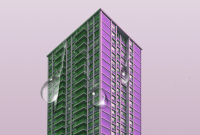Support strong Canadian climate journalism for 2025
This story was originally published by Grist and appears here as part of the Climate Desk collaboration.
In the summer of 1995, Chicago experienced one of the most deadly heat waves in U.S. history. As temperatures spiked that July, hitting 100 F for five straight days, 739 Chicagoans perished, many of them old folks in cramped apartments.
Two months later, the city began its 16-year project of tearing down the infamous towers of the Cabrini-Green housing project. For 50 years, the red-brick exterior highrises of Cabrini-Green, buildings synonymous with the birth of urban renewal and public housing in America, towered over the north side of Chicago. At one time, the highrises were home to 15,000 people, but decades of neglect turned once-sprawling grass yards and playgrounds into dirt fields and empty patches of pavement as the once-pristine brick facade crumbled above.

They might seem like unconnected events. But the majority of people affected shared two traits: they were Black, and they were poor. A report by the United Nations’ Intergovernmental Panel on Climate Change released earlier this month looked at the relationship between housing, building structures, and broiling city blocks and found that deaths from heat waves — like the one in Chicago — are not a coincidence.
“The (IPCC) news that came out ... shows us that you can’t chop up the challenges of meeting our everyday needs amidst climate change into neat silos,” Rick Cole, executive director of the Congress for New Urbanism, told Grist. “It’s impossible to solve our affordable housing crisis, our climate emergency, and people’s desire for improved quality of life against racism and disinvestment into separate silos.”
The IPCC report found that the single biggest contributor to amplifying heat and warming in cities is “urban geometry,” the relationship between city layouts, building construction, and density. The main problem driving the so-called “heat-island effect” is tall buildings. They create urban canyons, blocking winds from cooling things down, and locking in heat. Urban centres can range as much as 22 F warmer than nearby rural areas. Stoked by climate change, extreme heat kills more people in the U.S. than any other weather event. The report points to cities all around the world — especially Tehran, Iran, and Kolkata, India — that are warmer than their surroundings.
Festering within the heat is a housing crisis that has left one-quarter of adult Americans, disproportionately Black and Latino, without housing or struggling to pay rent, and local governments scrambling for solutions. Many housing experts labelled the demise of the Cabrini-Green towers as the death of affordable highrise housing across the country. Since then, however, cities and states across the country — in Ohio, New York City, and back in Chicago, developers are building taller affordable housing, going up, not out, in an effort to create density, walkable neighbourhoods where infrastructure costs are lower, and jobs, stores, and homes are closer together. The trick is finding a solution that offers everyone safe and quality housing without overheating the planet.
In tightly-packed places like New York City, home to more than 6,000 highrises, many of the effects of urban canyons and urban heat are unavoidable, said John Mandyck, CEO of the Urban Green Council in New York City. “New York City and other major cities, such as San Francisco, don’t have the flexibility to build out,” he said. “It’s about mitigating the climate impact of density and housing millions of people.”
Mandyck thinks there’s a way to maintain tall buildings, and even build a few more in cities that need them while combating both the housing and climate crisis. Cities could create gardens in the sky, which have successfully offered natural cooling and improved air quality in cities like Chicago, as well as planting trees and bushes to shade sidewalks and streets. Reflective roofing systems in New York City have led to more than 5.3 million square feet of roof spaces covered in a white reflective coating, preventing an estimated 2,500 tonnes of CO2 emissions every year.
Cities should also focus on cutting buildings’ carbon emissions, Mandyck said. In New York City, where supertall towers have taken over the skyline in recent years, buildings represent 70 per cent of carbon emissions, but a 2019 law is set to lower those emissions by 40 per cent in 2030, and 80 per cent by 2050.
Although Cole does believe mitigation practices like these are important, he says hyper-dense highrises will continue to pose problems. “Outside of Manhattan or the shoreline of Miami, from the standpoint of climate change, the real value is moving away from the artificial zoning limits that have required the development of highrise housing,” he said. “Even if skyscrapers were the answer to our manufactured housing crisis, it’s not even one per cent of the solution to our environmental problems because it adds challenges even as it mitigates some.”
More than 25 years after that first Cabrini tower came down, U.S. cities are much more equipped to tackle housing problems and the climate crisis, but action requires political willpower and individual sacrifices, experts say.
“We are out of balance right now on issues around climate change and urban development, and have been for a while,” Mandyck said. “But we have all the tools to come back in balance, to lower carbon emissions, cool down our cities, and to house and protect the people who have a lot at stake because of climate change.”








Comments
This article is misleading. The canyon effect from tall buildings that the article mentions is in no way a DRIVER of climate change. It does not CREATE heat, any more than an air conditioner destroys heat. Rather, it TRAPS heat in a particular place. This increases the impact of climate change in that place, which is bad for the people living there, and so it's likely worth doing something about. But it is not the same thing at all as something like a CO2 emission, or even a whole bunch of black asphalt absorbing sunlight. Cities with skyscrapers may tend also to do lots of CO2 emissions and have lots of black asphalt, but that's a distinct thing.
It is possible that tall buildings actually do drive climate change in some way. If, for instance, they generally require more CO2 emissions (to build, maintain and service) per square foot of living/office space than short buildings, that would make them actual drivers of climate change. But this may well not be the case, and the article doesn't bring it up.
Not a driver of climate change, but of temperature change in cities, partly bc hot air from ACs, residential tower laundry exhaust, etc. has nowhere to go.
In downtown Toronto, this effect is obvious.
There are several studies out there, one in particular by the engineering department at, I believe, the U of Toronto a few years back (sorry, my link to it is lost), that compare emissions between the dense downtown and the suburbs. They found that per capita life span emissions in downtown Toronto were a lot lower than the suburbs, even with the hit that concrete and steel initially give to downtown emissions during construction.
This is not surprising, because housing can never be divorced from the energy footprints of transportation, urban design and architecture. To critique the energy / emission footprint of cities one has to remember the massive build-out of vast freeway networks and the terrible urban form they imposed beyond downtown. Building more floor footage for fewer people way out at the suburban edge is not sustainable from any perspective, whether considering energy or finances. There is a price to pay for this egregious lack of urban efficacy. In many respects the single-family detached house on a large lot is obsolete in the age of climate action and urban financial policy. Bring on the Missing Middle (rowhouses, townhouses, low rises ...) to car-centric sprawling suburbs already!
The simplistic argument that towers alone are the problem doesn't add up. If the tower is clad in a black-tinted glass curtain wall only two sheets of glazing thick and is heated with gas and cooled by coal or gas-fired electricity running the air conditioners, then you have a massive problem. Moreover, the tall glass-clad towers of Toronto are having structural issues as the rubber and poly seals of the glazing deteriorate very quickly with the 80-degree temperature differential between summer heat waves and winter polar vortexes.
If the tower is light-coloured brick with smaller triple-glazed windows, heavily insulated exterior wall panels with thermal bridging breaks and derives its energy from a 40-storey wall of solar PV film and renewable electricity or a district heating system using renewables, then problem solved.
I'm with Rufus Polson on this. Canadian planners place more attention on the shade towers cast, implying that is a bigger problem in cold climates than the urban heat island effect. If one actually conducted measurements, then a suburban mall surrounded by a sea of asphalt and sprawl beyond that will top the charts in emissions and heat radiating from asphalt, not just from buildings alone. The solution? Urbanize the suburbs starting with malls being converted to self-sustaining town centres with a mix of housing types (not just towers), commercial and institutional space and large, shaded plazas catalyzed by a rapid transit connection to a frequent transit network.
Today, the GTA and Metro Vancouver illustrate the head-on collision between restrictive zoning for low density and the geographical limits of the land supply. Vancouver city has now run out of land, ergo huge price spikes in the last 20 years. Many commentators like to blame wealthy foreigners and their corrupt money, but that ignores the inconvenient truth that Vancouver has willingly protected insiders by preserving 81% of its residential-zoned land for sprawling low density detached house neighbourhoods when the city also saw a 13% growth in its population in the last decade. The only way to accommodate growth AND low density is to fill in English Bay for single-family subdivisions. The current and previous mayors have been pushing reasonable infill development, but a slight majority of council (conservatives) is still catching up while continuing the debate, which sounds distinctly like the clucking of chickens.